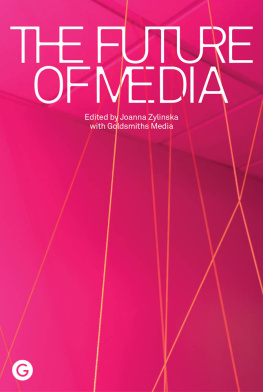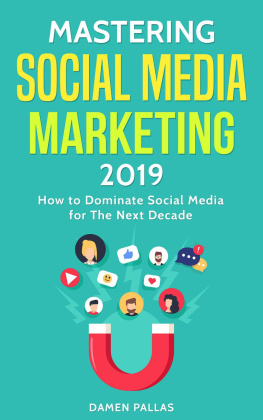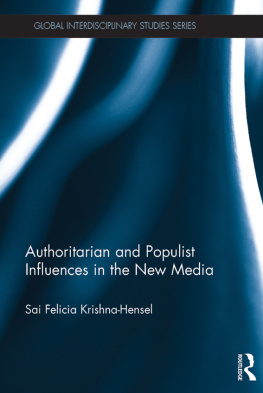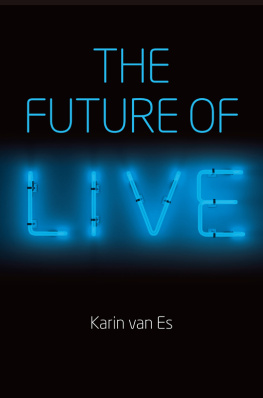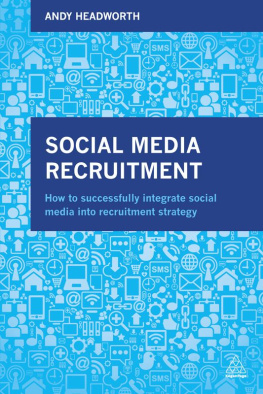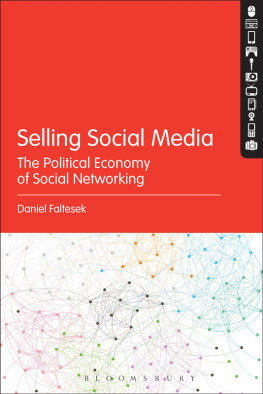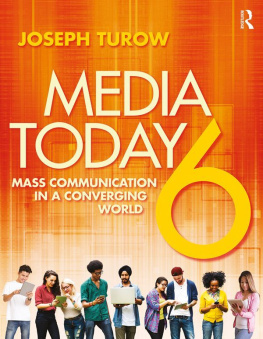Guide
The Future of Media
The Future of Media
Edited by Joanna Zylinska with Goldsmiths Media

Copyright 2022 Goldsmiths Press
First published in 2022 by Goldsmiths Press
Goldsmiths, University of London, New Cross
London SE14 6NW
Printed and bound by Versa Press, USA
Distribution by the MIT Press
Cambridge, Massachusetts, and London, England
Copyright 2022 Joanna Zylinska for selection and editorial material.
Chapter copyright belongs to individual contributors.
Cover image credit: Damian Owen-Board, from the series After the Trojan Horses, 2018.
The rights of Joanna Zylinska and Goldsmiths Media to be identified as the Authors of this work has been asserted by them in accordance with sections 77 and 78 in the Copyright, Designs and Patents Act 1988. Individual contributors retain the rights to be identified as the Authors or co-Authors of their own contributions to this work, these rights asserted by them in accordance with sections 77 and 78 in the Copyright, Designs and Patents Act 1988. Every effort has been made to trace copyright holders and to obtain their permission for the use of copyright material. The publisher apologises for any errors or omissions and would be grateful if notified of any corrections that should be incorporated in future reprints or editions of this book.
All Rights Reserved. No part of this publication may be reproduced, distributed or transmitted in any form or by any means whatsoever without prior written permission of the publisher, except in the case of brief quotations in critical articles and review and certain non-commercial uses permitted by copyright law.
A CIP record for this book is available from the British Library.
ISBN 978-1-913380-14-4 (pbk)
ISBN 978-1-913380-13-7 (ebk)
www.gold.ac.uk/goldsmiths-press

d_r0
Contents
Goldsmiths Media
Gholam Khiabany
Natalie Fenton and Des Freedman
James Curran
Lisa Blackman
David Morley
Clea Bourne
Milly Williamson
Anamik Saha and Sandra van Lente
Sarah Cefai
Daisy Asquith
Daniel Strutt, Andreas Schlegel, Neal Coghlan, Clemence Debaig and Youhong Friendred Peng
NG Bristow
Richard M. Shannon, NG Bristow and Mathapelo Mofokeng
Sue Clayton
Mirca Madianou
Richard MacDonald
Joanna Zylinska
James Burton
Sean Cubitt
Goldsmiths Media
This book is going to press at a time when speculations about the future not just the future of media, be it traditional or new, but also of the many other aspects of our socio-political life such as communication platforms, political frameworks or, indeed, the world itself are rife with existential anxieties. We are in the middle of a global pandemic caused by the Covid-19 virus; the most vulnerable groups in our society are experiencing significant threats to their lives and livelihoods; the rise of populism, nationalism and totalitarianism across the globe is threatening to undermine the working of democracy; the post-Brexit UK is looking with uncertainty at its future relationship with the European Union; the university as a place of research, learning and encounter has been converted into an online service provider; while the ice extent on the Arctic is at a record low. Given the protracted timeline of the publication process, by the time this book reaches its readers some of the specific events of late 2020 and early 2021 will have no doubt receded into a distant memory, but their wider global underpinnings and consequences are likely to be with us for a long time: inequality, racism and sexism; the weakening of democracy; progressing automation and surveillance of life and labour; the health and mental health crisis; the looming climate catastrophe. It is against this horizon that the present collection is set.
Since media operate as one of the dominant forces through which we make sense of ourselves and the world, it seems apposite that a collection which investigates the future of media would adopt such a wide socio-political horizon. Avoiding a narrow technicist perspective, the authors see media as inherently shaped by cultural forces, while also being involved in the shaping of both culture and society. Yet as part of this inquiry due attention is also paid by many contributors to the specific technological developments in the present media landscape, from close analyses of specific genres and platforms through to accounts of their own work on and with media.
The idea for this book arose a couple of years ago, when the Department of Media, Communications and Cultural Studies at Goldsmiths, which is one of the oldest and largest departments offering this configuration of subjects in the world, decided to work on a shared project that would bring together our multiple approaches, positions and ways of working. We agreed that the future of media theme should serve as an umbrella term for a more detailed exploration of various issues and questions, such as: Is the future of media to be primarily driven by ideas or by platforms? Is it to be led by academics or by the industry? By Silicon Valley or by China? By AI, by VR or by biotech? Under this umbrella we also wanted to explore the future of journalism as a profession and a way of being a media-making informed citizen. We wanted to look at the merging of media forms and formats, such as TV, film, photography and CGI, asking what media content, what platforms and what jobs this merging would bring about. Last but not least, we wanted to show how the university as one of the key places of media education and education in media literacy can be actively involved in shaping the future of media, and not just in commenting on it. In other words, we intended to reflect on, and demonstrate, how we can train better future media users and media workers.
The book is also a celebration of the increasing vivacity and importance of the discipline of media studies in the modern world, and of our department, which in 2018 celebrated its 40th anniversary. What may at first glance seem like a narrow approach coming from one specific academic institution opens up onto the wider debates, approaches and issues that make up this particular node of media education located in the impoverished borough of New Cross in London, UK, yet connected to many other global (and local) forces, ideas, industries and bodies. These connections are visible in many of the contributions, where the voices of our collaborators, interlocutors, practitioners in the media industries and, importantly, students come to the fore.
Last but not least, the book is an experiment in collaborative modes of thinking and working in an academic institution, in multiple voices and by means of multiple approaches, at a time when scholars and students are increasingly being implored to compete against each other rather than act collectively. By making it freely available in the electronic version on an open-access basis, our goal is to enable access to the debate on the future of media to as wide a readership as possible. But The Future of Media is more than a book; the project is accompanied by a web platform presenting various media projects that are either explicitly discussed in the book or that have developed in parallel to it. Indeed, crossing the theorypractice divide, the divide between thinking about media and making media, has been one of our goals. With this,

